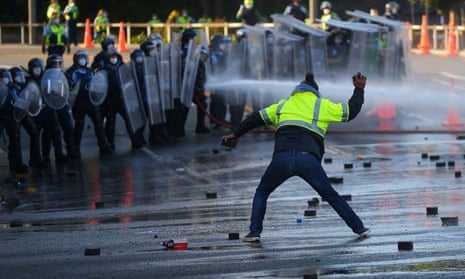The occupation of New Zealand’s parliament was fractured from the outset: fascists vied for control with controversial pastors, conspiracy theorists and more moderate anti-mandate protesters. And even as the occupation violently collapsed with rioters lobbing cobblestones at police, the divisions remained. Some shouted “burn it down”, while others tried to restrain them.
As New Zealand reacts to some of its darkest days in recent memory, these internal rivalries are, obscurely, a hopeful sign – a reminder there was far more division inside the protest than between the protesters and the wider nation.
Right-wing politicians took the occupation as evidence of a sharp rent in the social fabric. The National party leader, Christopher Luxon, gave a speech headlined “A Divided Society”. ACT’s leader, David Seymour, described the country as “splintered”. But while we cannot erase the images of parliament’s lawn burning, nor should we panic ourselves into a false assessment of how deep our social divisions run.
Hardline anti-vaxxers remain marginal. In the 2020 election, only 2% to 3% of New Zealanders voted for parties promoting Covid scepticism or conspiracies. Today, 94% of the eligible population is double jabbed, even if some signed up only because they feared losing their jobs.
Of course, the 6% of New Zealanders who are unvaccinated does represent tens of thousands of people, and that is alarming. So too the fact that, adjusted for population, New Zealand has three times more consumers of far-right Facebook content than the US. But they are still less than 1% of internet users.
New Zealand is not a house divided against itself. The country does not have two large, permanently opposed blocs – think Catholics and Protestants in Northern Ireland – whose enmity makes governing next to impossible.
It’s true some polls found 20% of New Zealanders supported the parliamentary occupation (almost all stated their opposition to vaccine mandates as their reason, rather than support for the darker elements of the protest).
Another poll found 25% of New Zealanders believed the government’s Covid response had gone too far.
But that same poll also showed 50% the country endorsed Jacinda Ardern’s policy, while 25% want it tougher still. For a democratic nation confronting a controversial policy that has required the state to curtail core liberties, these are natural tensions.
Disagreement is a sign not of dysfunction but of healthy democratic debate. Countries can also be surprisingly resilient. The 1981 Springbok tour was divisive in the extreme, yet those wounds healed with time.
New Zealand is, overall, a cohesive society. According to Victoria University’s Institute for Governance and Policy Studies, 80% of New Zealanders believe others can generally be trusted. (That is, they rate their trust in others to be at least 5 on a 10-point scale.) The same proportion has faith that the government will solve core social problems. Meanwhile, the Kiwis Count survey shows trust in public services has been high and rising, no matter who is in power.
Seen in this light, the parliamentary occupation represents a small, if frightening, loss of cohesion – a fraying at the edges, rather than a great rip in the social fabric. Some of the protesters were already marginalised – disproportionately poor and Māori, they had undoubtedly experienced racism and a sense of not belonging to their society. They were probably in the 20% who do not trust others, or government, very much.
Such concerns were then easily channelled into conspiracy theories and violence. This non-negligible group of New Zealanders have, with a worrying intensity and conviction, constructed an alternative reality. A world in which, to take just one touted scenario, the government has invented a fake virus in order to poison the population. They have broken away. The task now is to help them reattach themselves where possible, and ensure there are no further breaks.
That is no easy task, for it will require us, paradoxically, to be both tougher and gentler. Tougher in the sense that the police must never again be caught napping, violent and threatening speech must be more forcefully regulated, and something must be done to stop Facebook and other platforms pushing extreme content on users.
But gentler too, in that lectures about “following the science” won’t get people out of conspiracy theory rabbit holes – only slow, non-judgemental conversation with trusted friends will. We must also inoculate individuals against misinformation and help them reconnect with their communities, one of the surest defences against extremism. We must confront racism and the economic disparities that damage trust and suppress political engagement by making the poor feel (sometimes correctly) that the elites have everything sewn up.
This is a matter not of appeasing the protesters but of supporting the countless New Zealanders who are also poor and marginalised yet chose not to join a violent occupation. While the views of parliament’s occupiers do not yet represent a major threat to social cohesion, their wider spread would. That is the danger we must guard against. But we do so from a position of strength, because we are not hopelessly divided against ourselves.
Max Rashbrooke is a senior associate at New Zealand’s Institute for Governance and Policy Studies
